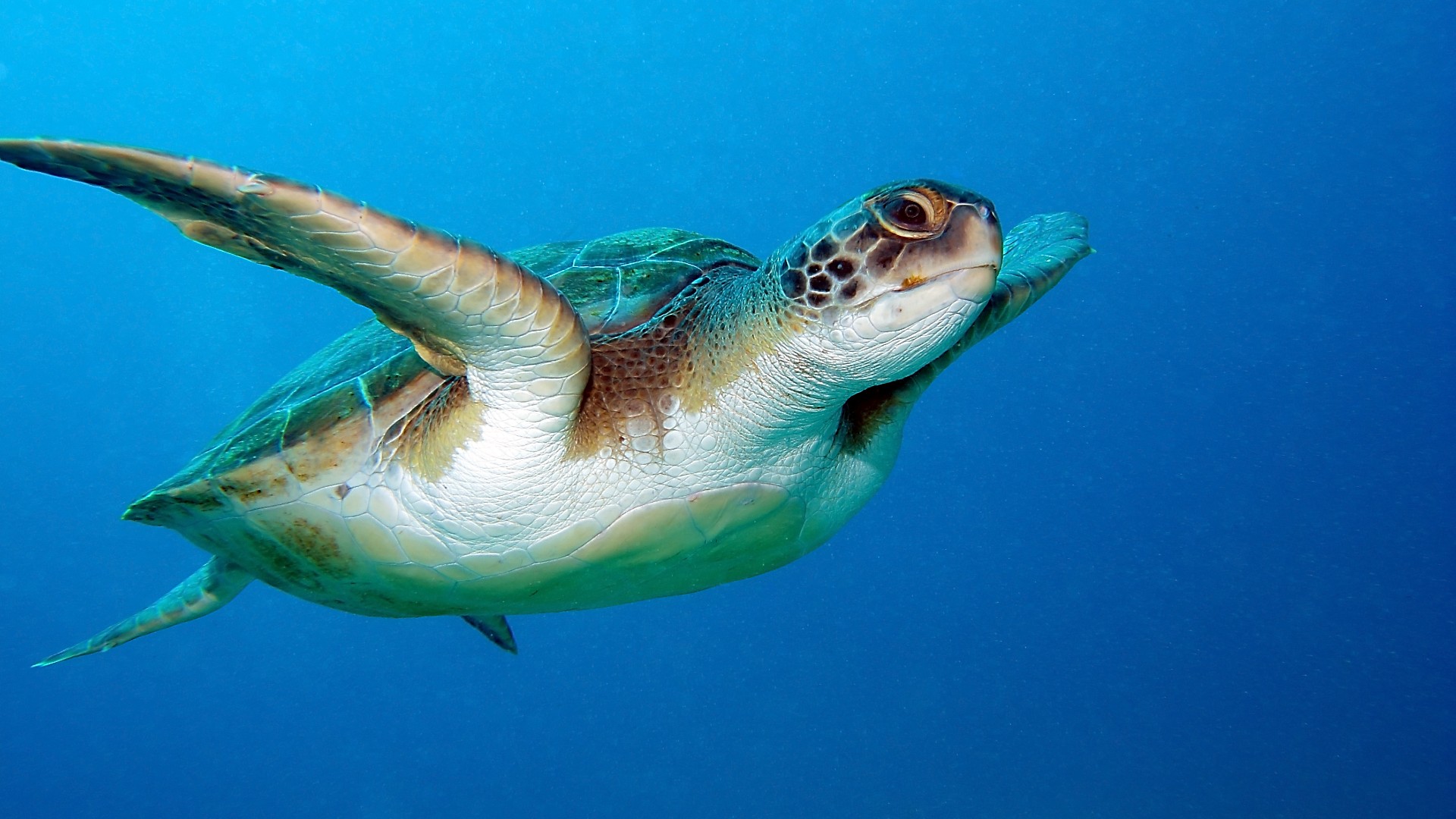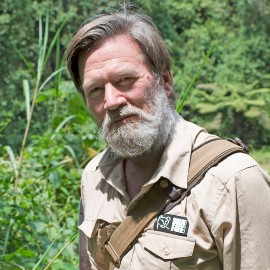Migratory species: Finding a way to protect them
Born Free’s Senior Wildlife Consultant, Ian Redmond OBE, reports from Uzbekistan following the 14th meeting of the UN’s Convention on the Conservation of Migratory Species of Wild Animals.

What do elephants and sharks, antelopes and albatrosses, turtles, lions, falcons, guanacos and gorillas have in common? Answer: They all migrate according to seasons or circumstance, and they are all threatened with extinction.

Ian Redmond OBE
When endangered animals move across international boundaries, clearly there must be some coordination and cooperation between the governments concerned to protect them, whether they be in neighbouring countries sharing contiguous habitat or distant countries along the flyways of migratory birds or swimways of whales that encircle the globe. For this reason, the UN’s Convention on the Conservation of Migratory Species of Wild Animals (CMS) came into force in 1985 and has now been joined by 133 countries, known as Parties to the Convention.
This month saw the Government of Uzbekistan host the 14th meeting of the Conference of the Parties #CMSCoP14, the Convention’s highest decision-making body, to discuss progress on a range of issues and proposals to list additional species in need of international protection. Born Free has been a partner NGO since 2018 and its Policy Team brings its expertise and compassionate conservation perspective to the proceedings. The CMS follows UN rules allowing properly accredited civil society observers to attend, but goes further than many other international biodiversity conventions by encouraging NGOs to contribute ideas to improve the text or add information to documents, provided that Parties agree.
I have attended CMS meetings since 2010 as a CMS Ambassador but this time was delighted to be asked to represent Born Free.
More than 2,000 delegates from around the world gathered in the opulent Congress Centre outside Samarkand, an ancient crossroads city in Central Asia on the historic Silk Road to China. This seemed a fitting place to hold a meeting about migratory species, and indeed one of the outcomes, after years of negotiations, was an agreement on a Central Asian Flyway spanning 30 Range States of migratory birds, including the establishment of a coordinating unit in India with financial support from the Indian Government. Like all the other decisions and resolutions, it was adopted by consensus after detailed negotiations over the exact wording, often late into the night.
Of particular interest to Born Free were the 14 species that were added to the Appendices of the Convention, including the Eurasian Lynx, Pallas’s Cat, Guanaco and Sand Tiger Shark. But as more than one delegate observed, listing a species is hardly a matter to be celebrated (even if it is the result of years of hard work) because a listing is an admission of failure to protect that species from the threats it faces. Not only does a population decline mean the species is in danger, it also means that whatever role that species plays in its ecosystem is decreasing proportionately – and this affects the services provided by that ecosystem, whether the oxygen we breathe, the water we drink or the food we eat. To say nothing of the increased sequestration and storage of carbon attributable to elephants in forests and whales in the oceans, who are our allies in the fight against dangerous climate change. Migratory species matter to us all!
Other measures known as ‘Concerted Actions’ were adopted to safeguard Chimpanzee cultural diversity, Giraffes, Lynx and several other species; and important resolutions on ‘cross-cutting issues’ such as climate change, ecotourism, wildlife health and zoonotic diseases were tabled for discussion. The Born Free Policy Team worked for weeks beforehand to prepare suggested amendments to strengthen the draft decisions and resolutions, and I had the honour of making several interventions based on this work, most of which were well received and endorsed (sometimes with modifications) by the Parties.
At the start of the week-long conference, the first ever report on The State of the World’s Migratory Species was launched – a detailed scientific assessment which makes sobering reading:
- 70 CMS-listed migratory species – including the steppe eagle, Egyptian vulture and the wild camel – have become more endangered over the past three decades.
- Only 14 listed species have an improved conservation status, including blue and humpback whales, mountain gorillas, the white-tailed sea eagle and the black-faced spoonbill.
- The worst category is CMS-listed species of fish – including migratory sharks, rays and sturgeons – whose populations have declined by 90 per cent since the 1970s, and are facing a very real risk of extinction.

Minister Abdukhakimov and Amy Fraenkel, planting trees (c) Ian Redmond
Inger Andersen, Under-Secretary-General of the United Nations and Executive Director of the United Nations Environment Programme said: “Today’s report sets out the evidence that unsustainable human activities are jeopardizing the future of migratory species – creatures who not only act as indicators of environmental change but play an integral role in maintaining the function and resilience of our planet’s complex ecosystems. The global community has an opportunity to translate this latest science of the pressures facing migratory species into concrete conservation action. Given the precarious situation of many of these animals, we cannot afford to delay, and must work together to make the recommendations a reality.”
In her opening remarks to the conference, she also used the term ‘migratory beings’ and described them as ‘messengers of nature’ whose message we ignore at our peril. As well as loss and fragmentation of habitat, perhaps the biggest threat these species face is illegal and unsustainable ‘take’ – i.e. the killing and capturing for consumption or trade, whether over-fishing in the seas or over-hunting on land. This brings the CMS into the realm of food security for indigenous people and local communities who may depend on seasonally abundant wildlife for their survival. Born Free urged Parties to avoid language that suggested CMS should ‘promote conservation and sustainable use’, but instead should ‘promote conservation and ensure that any use was sustainable’ – a subtle but important difference.
The chairman of the Committee of the Whole, comically labelled ‘CoW Chair’ was Prof. Colin Galbraith, whose calm demeanour and friendly Scottish burr guided dissenting views to reach compromises even over such controversial topics as deep sea mining and zoonotic diseases. When Parties had divergent views, they were instructed to thrash out their differences in Working Groups during lunchtimes and evenings and present a revised text for consideration in a later session. One by one, more than 100 documents were presented, debated, revised and eventually adopted on the final day by the Plenary, chaired by Mr Aziz Abdukhakimov, Uzbekistan’s Minister of Ecology, Environmental Protection and Climate Change. After checking there were no objections to each decision in turn, he struck the gavel saying it is hereby adopted – thereby bringing the decision into international law.
On a freezing Friday afternoon, Minister Abdukhakimov and Amy Fraenkel, Executive Secretary of the CMS Secretariat planted a tree and invited hundreds of delegates to do the same in what will become a permanent eco-park to commemorate CMS CoP14, the first major UN meeting to be held in Central Asia.
At the end of such an intense, exhausting week, it is tempting to think the job is done, but in reality the hard work begins now, in order to ensure these decisions are effectively implemented and make a positive contribution to wildlife and ecosystems.
Born Free will continue to play its part in doing so, by supporting the governments and communities where we work to protect migratory species in the wild.
